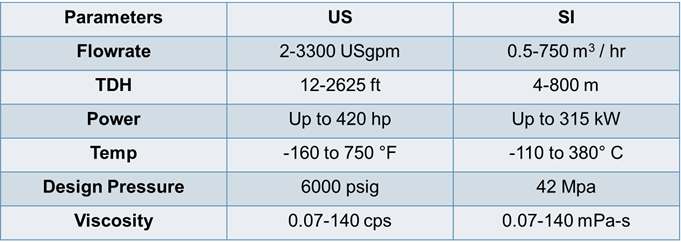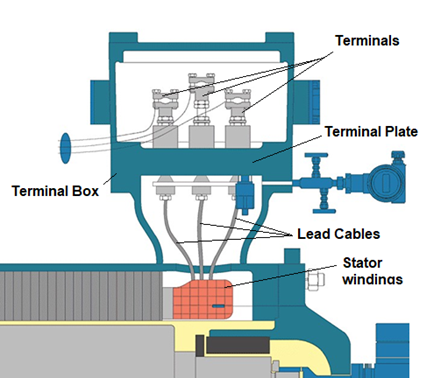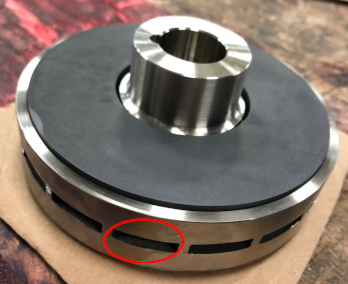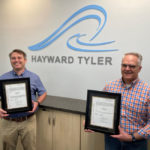Question: Do you ever use PEEK material for the Primary Containment Shell?
Answer: Hayward Tyler has never used PEEK material for the can (Primary Containment Shell) within a Canned motor pump, however it has been considered. The thickness of PEEK material would need to be greater than that of the existing materials used which would adversely affect the motor efficiency. Additionally, using a PEEK can would require additional design considerations for fastening to the mating pieces.
Question: What material options are available for the Sleeve Bearings?
Answer: Sleeve Bearings in canned motor pumps are typically a Carbon Graphite or Silicon Carbide material. Most applications can be serviced by one of these two materials, but if there are other customer requirements accommodations can be made.
Question: What is the clearance between the can and stator?
Answer: Typically, the clearance between the can and stator diameters is 0.8-1.4mm (0.030-0.055″). The clearance changes depending on the motor frame size.
Question: Are these pumps API685 compliant?
Answer: Canned motor pumps are commonly designed and built to API685 standards. Hayward Tyler offers Canned Motor Pumps complaint to API685.
Question: Are solids tolerated?
Answer: Yes, solids are tolerated to an extent before you need to add features to deal with them. In general, pumps with standard SiC bearings can handle 0.02 mm particle size and ~ 1% volume.
Most cases with solids are on a per application basis where the best solution is found during the application engineering process rather than with general parameters. If it is deemed unsuitable for the solids to be inside the motor an internal mechanical seal (that does NOT leak to atmosphere) and a metering pump can be used.
Question: Are there process fluid limitations (high viscosity, for example)?
Answer: In general, the limitations of process fluids are the solid concentration, viscosity, compatibility with fluid film bearings, and temperature. See the below parameters for our typical off-the-shelf canned motor pumps as a reference.

Question: At what temperature is additional cooling required?
Answer: Typically, the maximum fluid temperature in the motor is 120°C before cooling is required. The properties of the fluid are important to determine whether any cooling is required. Additionally, motors above 200kW typically require external cooling.
Question: Is the stator cavity pressurized? How does this pressure value compare with the process fluid pressure?
Answer: This depends on the stator encapsulation method used. If there is a solid encapsulant present in the stator, then this area does not need to be pressurized. If the stator encapsulant is either a liquid or gas, then the stator cavity would be pressurized. In our case, we use either solid encapsulants or Nitrogen gas pressurized to between 0.1-0.2 bar(g).
Question: Are the motor terminals inside of the motor shell behind the stator can?
Answer: The motor terminals are located in an IP55 rated terminal box. The 3-phase windings are jointed to lead cables inside the stator shell. The lead cables connect to the terminal stems either below the terminal plate or pass into the terminal box using a sealed connection.

Question: Do you have an auxiliary impeller to drive process fluid thru the motor?
Answer: Depending on the required circulation path an auxiliary impeller can be used. In simple configurations the natural buoncy of the fluid is enough to circulate around the flow path. The below image shows a typical auxillary impeller on a Canned Motor Pump rotor.

In applications where there is a thrust disc, the disc often acts as an auxiliary impeller too. This can be seen in the below image of a thrust disc, where the slots on the side act like a closed impeller’s slots.

Question: You mentioned 400°C possible operation and saying also that the insulation material organic would allow that. Is that a proprietary material?
Answer: Our HV-X model uses a non-organic insulation material to allow the temperature of the process fluid to be this high without cooling water. The process fluid temperatures for this model and the additional features are as follows:
Operating Temp ≤ 350℃, Super C Insulation, No External Cooling Required
350℃ < Operating Temp ≤ 400℃, Super C Insulation, Additional Air Cooling Necessary
Question: Why, apparently, the aspect ratio for the motor shell is larger than a conventional induction motor?
Answer: Fluid friction drag loss and eddy current can loss are two efficiency losses associated with canned motors; Both are proportional to the diameter of the stator bore (rotor O.D.) Hayward Tyler motor designs take these main loses into consideration along with the bearing span to optimize the overall design of the canned motor.
Question: Shouldn’t we be afraid of debris/crystal etc. passing in the rotor-stator gap? Can you inform the typical size for such type of gap? Is the can material sufficient hard to withstand eventual abrasion?
Answer: The gap between the rotor and stator can is 0.8-1.4mm (0.030-0.055″) depending on the motor size. Understanding the type and size of the debris/solids that are found in the process fluid is critical to whether it would be acceptable to be circulated in the motor. When selecting a Canned Motor Pump, it is important to have the most accurate information possible so the application engineer can determine the proper configuration. This may mean a backflushing system, a barrier fluid to keep the process fluid out of the motor, or that a Canned Motor Pump is not the proper selection. In cases where solids are present, both Inconel and Hastelloy (the most common can materials) have very high resistance to chemical and abrasion corrosion.
Question: How is the can supported in the stator cavity? The pressure differences on either side of the can would seem to either lead to its collapse or its lateral expansion, why does it not do this?
Answer: The stator can is supported by the lamination pack and using back-up sleeves to span the distance between the lamination pack and the end plates. The can is fusion welded to the end plates and then hydroformed. The hydroforming expands the can so that it is sitting flush against the supporting features. During manufacture it is common to perform a nitrogen or helium leak test to ensure the stator is completely sealed. The stator can and supporting features are designed to withstand a typical hydrotest of 1.5x the rated pressure.
Question: Is there a maximum discharge pressure or pressure ratios (Suction/Discharge) for Canned Motor Pumps?
Answer: There is no maximum discharge pressure for Canned Motor Pumps, but our standard maximum rated pressure is 40 MPa. The maximum differential head allowable is 600m when the design pressure is less than 40MPa. It is possible to for us design Canned Motor Pumps with a rated pressure of 55 MPa but it would be a specially designed product.
Question: Are CMPs Suitable for vacuum (Suction) to high pressure conditions? This is for potentially upset conditions that may see vacuum suction situation causing seal failures on a standard centrifugal pump. What would be the NPSHa requirement in that case? Answer: All Canned Motor Pumps are designed as pressure vessels and each Canned Motor Pump can accommodate conditions from vacuum to high pressure. The best way to know if your application would be suitable for a Canned Motor Pump is to give specific conditions for evaluation. Like most centrifugal pumps, having adequate NPSHa (typically greater than o.6m above the pump NPSHr) would typically be required to avoid pump issues such as cavitation.
Question: Does the rotor have windings on them, or magnets?
Answer: Canned Motor Pumps use a squirrel cage rotor encompassing a lamination pack and rotor bars connected to short circuit rings at both ends. There are no windings or magnets on the rotor.
Question: Are the vibration monitors accelerometers on the casing or can you have proximity probes to monitor the shaft?
Answer: The best method for monitoring the condition of the Canned Motor Pump is using a bearing wear monitor, temperature windings and motor current. Canned Motor Pumps are naturally self-dampening due to being filled with fluid, therefore monitoring and diagnosing using vibration can be difficult. When supplied the probes would be accelerometers.
Question: Because the rotor is submerged in the pumped liquid, I’d assume that the efficiency is reduced compared to an external motor because the rotor has to be spun in the pumped liquid. What would be a typical motor efficiency?
Answer: Typically, Canned Motor Pumps are selected due to the increased safety and reduced maintenance they offer. They are typically less efficient than air cooled motors because of the fluid inside the motor creating a larger “air gap” between the rotor and stator along with additional frictional drag on the rotor. It is more common to measure wire-to-water efficiency due to the motor and pump using a common shaft. The pump efficiency can vary so the total efficiency on the Canned Motor Pump can also vary. For the motor alone the typical efficiency is around 10-15% below an air-cooled motor.
Question: Due to the fact that the process fluid is used as a bearing lubricator, are all fluids suitable for use in a Canned Motor Pump?
Answer: Not all fluids are suitable for a fluid film bearing. Typically, you need a clean fluid with a viscosity between .07-100 cP. The material used for your bearing can vary depending on the reactivity with your fluid. Most fluids are applicable though, anything from hot oil, water, acids, or caustics.
Question: What is the max particle size allowable by the bearings?
Answer: In general, pumps with standard SiC bearings can handle 0.02 mm particle size and ~ 1% volume. Most cases with solids are on a per application basis where the best solution is found during the application engineering process rather than with general parameters. If it is deemed unsuitable for the solids to be inside the motor an internal mechanical seal (that does NOT leak to atmosphere) and a metering pump can be used.
Question: How are the bearings lubricated in a Canned Motor Pump?
Answer: The bearings are typically lubricated using the pumped fluid, or in some rare occasion a barrier fluid. There are various circulation paths for Canned Motor Pumps that are primarily dictated by API685. The most basic circulation plan has a few small holes in the front bearing housing that allows a controlled amount of the pumped fluid into the motor. This fluid lubricates the bearings.
Question: Why would you use Canned Motor Pumps with Cryogenic fluids?
Answer: Canned Motor Pumps are the safest pumping solution due to the fact they have no dynamic mechanical seal that leaks to atmosphere. Additionally, they offer double containment against any kind of leakage. In the case of cryogenic fluids, these can be dangerous if they leak to the atmosphere and can be difficult to seal using a mechanical seal system.
Question: What are the limitations of these pumps in regards to flowrate, head, design T, design p?
Answer: The typical parameters are shown in the table below however we are able to go above or below these values on a case-by-case basis.

Question: What will cause repeated bearing failures in a Canned Motor Pump?
Answer: When experiencing repeated bearing failures, it is important to understand the operating conditions of the Canned Motor Pump. However, in a general sense the most common failure mechanisms for canned motor bearings are:
- Lack of fluid in the bearings: If the canned motor is not vented properly prior to start-up or the liquid level drops, then air/gas can enter the bearings. This displaces the fluid and therefor the bearing cannot develop the suitable fluid film required for the bearing to operate.
- Overloading of the bearings: The most common example of this would be that the pump is not operating within its design region. This means that the forces being generated by the impeller and reacted at the bearings are larger than designed for.
- Particulate entering bearings: If particulate enters the bearings, it can score the surfaces and displace the fluid that is designed to be in the bearing. This causes premature wear of the bearings surfaces and can reduce the load capacity of the bearing.
Question: Have you had customers successfully use a canned pump in hydrogen fluoride (HF) service?
Answer: We have many customers using Canned Motor Pumps in HF service. The typical model is a HN type, reverse circulation. This passes the fluid through the motor once before returning to the suction tank.
Question: In Cryogenic applications how do you ensure proper bearing lubrication considering the process fluids are prone to boiling when they go through the pump?
Answer: The Canned Motor Pump type selected for Cryogenic fluids is typically a “reverse circulation” (HN Model) flow path which does not recirculate the cryogenic fluid back to the pump end, but instead circulates back to the suction tank or other area in the plant. This minimizes the heat picked up in the fluid to avoid vaporization. It is important at the application engineering stage to confirm the pump fluid properties alongside the known temperature rise through the motor.
Question: The spec’s showed a maximum temperature of 750 Deg F. Would the pump/motor life be reduced if operated near or at those temp’s?
Answer: The Canned Motor Pump type is selected based on several parameters including the pump temperature. The pump materials of construction are selected such that there would be no concern of reduced life. For pump end temperatures approaching 750°F a heat exchanger would typically be used with the motor. The main factors effecting motor life are the temperature of the motor and fluid temperature for the bearings. Depending on the expected motor temperature different insulation classes are used including Class H (180°C), Class 200°C or Class 220°C. The appropriate insulation class is selected such that operation at high pump temperatures would not effect the winding life. The required cooling water temperature and flow rate is calculated for the heat exchanger based around motor temperature and fluid temperature to ensure the fluid film bearings can handle the rotodynamic forces.
Question: Can Canned Motor Pumps be used for supercritical applications?
Answer: Yes, Canned Motor Pumps are a good solution for pumping supercritical fluids. Typically, supercritical fluids are at high pressures which can causes issues for mechanically sealed pumps. Canned Motor Pumps are completely sealless and can handle large system pressures whilst operating reliably.
Question: Are there any fluids that interfere with the magnetic induction of the motor in those applications where fluid is flowing through the motor?
Answer: Canned Motor Pumps are three phase induction motors, like an air-cooled motor, except that the gap between the rotor and stator is filled with a fluid instead of air. A fluid that has magnetic properties could affect the rotodynamics of the rotating shaft of the Canned Motor Pump due to that fluid exhibiting magnetic forces local to the shaft. The specific fluid properties would need to be understood to determine if a Canned Motor Pump is compatible with the specific fluid.
Categories: Product Knowledge











